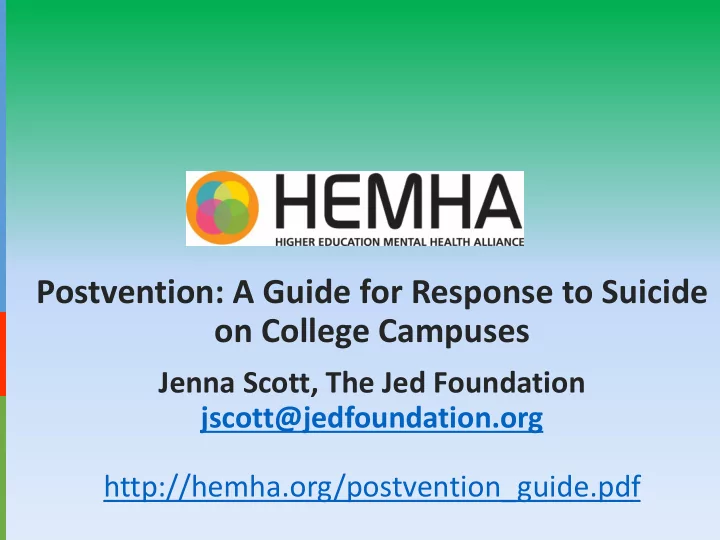

Postvention: A Guide for Response to Suicide on College Campuses Jenna Scott, The Jed Foundation jscott@jedfoundation.org http://hemha.org/postvention_guide.pdf
Higher Education Mental Health Alliance (HEMHA) MISSION: To provide leadership through a partnership of organizations to advance college mental health. PURPOSE: The Alliance affirms that the issue of college mental health is central to student success, and therefore is the responsibility of higher education.
THE ALLIANCE… An Inter-Association • The American erican Coll llege e Counseling nseling Associa ociation ion (ACCA) A) • The American erican Coll llege e Healt alth h Associ ociation tion (ACHA) HA) • The Ameri erican can Coll llege e Personn onnel el Associ ociation tion (ACPA) A) • The American erican Psychia hiatri tric c Associa ociation tion (APA) ) • The American erican Psycho hological logical Associa ociation tion (APA) A) • The Associ ociation tion for r Univ iver ersi sity ty and Coll llege e Counsel nseling ing Center ter Direct ector ors s (AUCCCD) ) The Jed Founda ndation tion (JED) • The National ional Associa ociation tion of Student ent Person onnel nel Administr inistrator ors s • (NASP SPA) A)
Our Philosophy/Goals • Educating colleges about suicide postvention • Help schools create a plan/protocol for suicide postvention before a crisis occurs • Useable during a crisis, as well • Simple and useable • Share guidance from experts
Outline • Define Postvention • Goals of Postvention • Planning and protocols • Forming a Committee • Communications • Clinical Services • Memorials and Related Events • Getting Back to Routine
Defining Postvention • Psychological support, crisis intervention and assistance to those affected by a campus suicide • Planned interventions intended to: – Facilitate grieving or adjustment process – Stabilize the environment – Reduce risk of negative behaviors – Limit the risk of further suicides through contagion
Goals of Postvention • Help those most directly impacted deal with trauma/grief • Reduce intensity of reactions across the whole population • Stabilize campus community • Restore semblance of order and routine • Prevent further suicides • Educate community about suicide and varied responses • Allow for learning from current postvention efforts to improve future prevention, postvention and response efforts
Planning • Ideally done in advance – in the aftermath of a campus suicide, when emotions and tensions are high, it is very difficult to respond without having guidelines or plans in place. • Postvention planning should emphasize the importance of interdisciplinary communication and coordination. • Various offices, faculty, and community members will be responsible for deploying aspects of the postvention plan.
Forming a Postvention Committee • Identification of postvention leaders and coordinators who will deploy postvention plans • Identification of other key stakeholders on campus • A chair (or lead coordinator) should be appointed to the committee • The postvention coordinators could overlap with other campus teams or function as a sub-committee of previously established campus teams (such as campus BIT team)
Interdisciplinary Communication and Coordination • Office and individuals that may have roles in suicide postvention and should therefore be prepared to respond: – student affairs leadership – counseling and psychological services leadership – health center – disability office – campus security/police – financial aid/registrar or enrollment management – campus media relations/public relations office – residence hall leadership – legal affairs/risk management office – chaplaincy – international student office – campus office of environmental safety/local department of health
Communications • Protocols need to address how to best communicate information to the community • Be as open and direct as possible • Information travels fast via technology and social media – postvention committee needs to be ready to communicate quickly • Balance speed with efforts to insure accuracy of information reported • Safe messaging considerations and how communicating about suicide can influence contagion • Communicating with: – Close friends – Surviving family – Faculty
Safe Messaging http://suicidepreventionmessaging.actionallianc eforsuicideprevention.org/safety www.reportingonsuicide.org
Clinical Services One of the primary goals of postvention is to help individuals impacted by a campus suicide deal with the trauma and grief they experience as a result. Postvention protocols should outline thoughtful and easily accessible clinical interventions that can help the campus community regain emotional stability. Various activities need to occur in tandem: • Promote vigilance of high risk groups – individuals and groups that were close to or connected with the deceased – those with psychiatric illnesses such as depression, severe substance abuse, severe personality disorders and psychosis • Group discussions and support sessions • Individual clinical support • Support for responders
Memorials and Related Events • Balance the needs of survivors to honor the deceased/take action with the risks of others imitating or modeling the suicidal behavior • Under ideal circumstances it is best not to have or limit memorial services – This may be impractical and in fact inappropriate if the school typically holds memorials after other student deaths or if there is tremendous emotional pressure from the family or the community to have one. • Input from family of the deceased • Seek consultation about how to effectively and safely hold a memorial event • Protocols should emphasize plans for honoring the deceased in other ways besides memorial events, as well
Getting back to Routine Postvention programming aims to both support community mourning and processing of the campus death while also helping the community return to routine to the greatest extent possible as soon as is feasible. • Getting back to a routine is helpful in the healing process. • Following postvention deployment is a window of opportunity to transition from postvention (back) to prevention – e.g., revamping gatekeeper training program
Postvention: A Guide for Response to Suicide on College Campuses http://hemha.org/postvention_guide.pdf
Recommend
More recommend